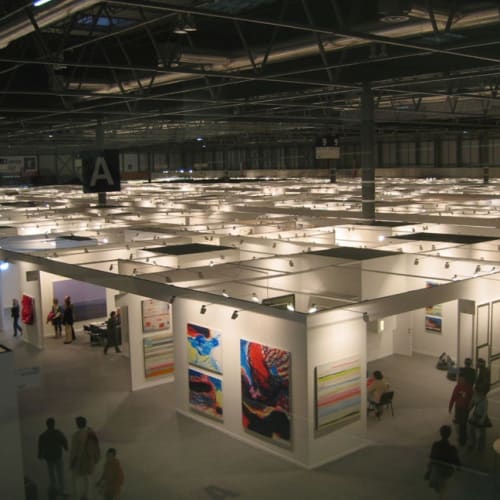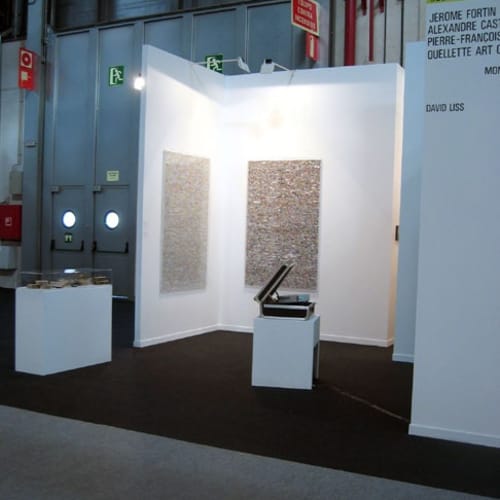February 9 - 13 2006
ARCO’06, Madrid
New Territories: Cityscapes
Jérôme Fortin + Alexandre Castonguay
Selected by David Liss, Director of the Museum of Contemporary Canadian Art (MOCCA)
Established in 2001, Pierre-François Ouellette art contemporain (PFOAC) is a commercial, contemporary, Montréal art gallery committed to showing photography, new-media, drawing, sculpture, installation art, and works on paper by a diverse group of Canadian multidisciplinary artists that includes: Marc Audette, Alexandre Castonguay, Luc Courchesne, Michel de Broin, Jérôme Fortin, Karilee Fuglem, Louis Joncas, Marie-Josée Laframboise, John Latour, Marie-Jeanne Musiol, Ed Pien, Roland Poulin, Michael A. Robinson, Annie Thibault and Johannes Zits.
Located one block west of the Musée d’art contemporain, and in the heart of Montréal, the gallery provides its artists an opportunity and a venue to show exploratory, museum-quality works alongside smaller art works more suited for private collections. Through its exhibition programming, participation at national and international art fairs, publications and web presence, the gallery provides continuity to the careers of its artists. The goal of the gallery is to develop a strong collector base for its artists.
The gallery participation in fairs has been marked by invitations in special events which includes: Free Style at ARTFORUM Berlin 2003 and 2005, Fresh Avant-Garde at Toronto International Art Fair 2004 and 2005, DiVA (New York), DiVA (Paris) 2005, and International Invitational Section at Art Chicago.
Our presentation at ARCO’06, in the New Territories: Cityscapes section will feature works from Alexandre Castonguay and Jérôme Fortin. This thematic presentation offers new ways of looking at a cityscape either conceptually or metaphorically.
Through his use of new technologies and digital art, Alexandre Castonguay explores both the applications and the limits of these media. He creates, for instance, technological environments in which the observer is acutely aware of his own relationship to the work of art. Referencing design, technological production and art history serves the twofold purpose of anchoring his art to these traditions and of questioning the expectations and beliefs that are associated with them. Not only does Castonguay work with digital photography and interactive installations, he also contributes to the development of Open Source software.
At ARCO’06, Alexandre Castonguay will present Portapak, a long video pan captured from a train leaving Ottawa and arriving in the heart of Montreal. An embedded touch screen enables the viewer to determine its speed and direction. Accompanying this work will be some large digitally-edited photographs from his "Constructions" series. These digitally-edited images consist of more than 250 photographs that create a 360 degree view on a two dimensional surface of urban landscapes like a building under construction in Montreal and a late 19th Century observatory in the middle of a manicured landscape in the heart of Ottawa.
For the past 10 years or so, Alexandre Castonguay has produced a multidisciplinary body of work centred around digital photography, video, computerized installation and the Internet. A native of the Outaouais region, where he lives and works, Castonguay teaches in the Department of Visual Arts at the University of Ottawa. He is also a founding member and the artistic director of Artengine, a website run by and for visual and media artists. A politically committed artist, he contributes to developing the field of free software. He has participated in numerous solo and group exhibitions in Québec, across Canada and abroad, notably in New York, Los Angeles, Santiago and Mexico City. In 2004, he won the Graff Award instituted in memory of Pierre Ayot. Currently his work can be seen at Musée d'art contemporain de Montréal in his first solo exhibition titled Elements.
In contrast, with his sculpture-installations, Jérôme Fortin combines his work with cabinets of curiosities — the 17th century's practice that gathered material evidence of the ‘exotic’ cultures the collectors encountered in their travels — and the 20th and 21st centuries' practice of mass consumption. Corks, plastic bottles, books, matches, nails, and tin cans are cunningly handled and assembled in several series of visual curiosities. Their colours, forms, textures, and volumes suggest the flowers, seashells, jewelry, and amulets once collected by the curious for their exotic flavour. The poetic, mysterious allure of Fortin's sculptures sets aside the usual aspect of everyday objects so as to exalt in our contemporary gaze.
At ARCO’06, Fortin will present a new work that will be partly created in Madrid in the continuity of the process he followed to create his sculpture New York, New York (2001), now in the collection of the National Museum of Fine Arts of Quebec. In New York, Fortin produced it for Growth and Risk: an exhibition of 13 artists from Quebec organized around the concept of assemblage, and the combination of disparate objects issued directly from the everyday world or that reference that world. On September 11, 2001, the New York Times published a major article on his process of creation: Plumbing a City's Curiosities in the Name of Art by Randy Kennedy.
Jérôme Fortin will also present works from his newest series Screens that he is created for the group show L’envers des apparences at the Musée d’art contemporain de Montréal this Summer. These large installations are created with simple sheets of printed paper taken from comic books that he cuts end-to-end and glues onto the wall. He creates variations on motifs which, by it patterns and sheer size, recall movie screens and monitors, where the basic unit pixels are revealed in a estranged way. These works continue his formal exploration that he examined in Tondos which will also be featured. Tondos is a series of prints created in relation to the Seascapes presented at ARCO’05 and featured on the front page of ABC de ARCO (numero 3, February 2, 2005).
Jérôme Fortin, recipient of the 2004 prix Pierre-Ayot, has had work shown in several group exhibitions in Quebec and abroad, such as the Biennale de Montréal in 1998, Galerie UQAM in 2000, and the Officina America in Bologna in 2002. His first solo show within the institutional framework of a museum, Ici et là, was presented in 2002 at the Musée d'art de Joliette and is currently touring in Canada. It will be presented in Tokyo in 2006. His work can be found in the collections of the Musée national des beaux-arts du Québec, the Musée d'art contemporain de Montréal, the Musée d'art de Joliette and several private collections.
Special thanks to Canadian Heritage, Canada Council, Société de développement des entreprises culturelles du Québec and MOCCA (Toronto)




